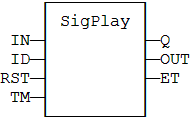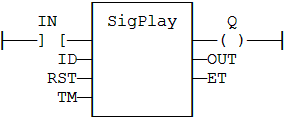SigPlay
Function block - Generate a signal defined in a resource.
Inputs
|
Input |
Data type |
Description |
|
IN |
BOOL |
Triggering command. |
|
ID |
DINT |
ID of the signal resource, provided by SigID function. |
|
RST |
BOOL |
Reset command. |
|
TM |
TIME |
Minimum duration in between two changes of the output. |
Outputs
|
Output |
Data type |
Description |
|
Q |
BOOL |
TRUE when the signal is finished. |
|
OUT |
REAL |
Generated signal. |
|
ET |
TIME |
Elapsed time. |
Remarks
The ID argument is the identifier of the signal resource. Use the SigID function to get this value.
The IN argument is used as a Play / Pause command to play the signal. The signal is not reset to the beginning when IN becomes FALSE. Instead, use the RST input that resets the signal and forces the OUT output to 0.
The TM input specifies the minimum amount of time in between two changes of the output signal. This parameter is ignored if less than the cycle scan time.
This function block includes its own timer. Alternatively, you can use the SigScale function if you want to trigger the signal using a specific timer.
ST Language
MySig is a declared instance of SIGPLAY function block.
MySig (II, ID, RST, TM);
Q := MySig.Q;
OUT := MySig.OUT;
ET := MySig.ET;
FBD Language

LD Language

|
|
SigPlay |
|
IEC 61131-3 Automation platform > Programming - Reference guide > Advanced operations > SigPlay |
Created with the Personal Edition of HelpNDoc: Full-featured multi-format Help generator

